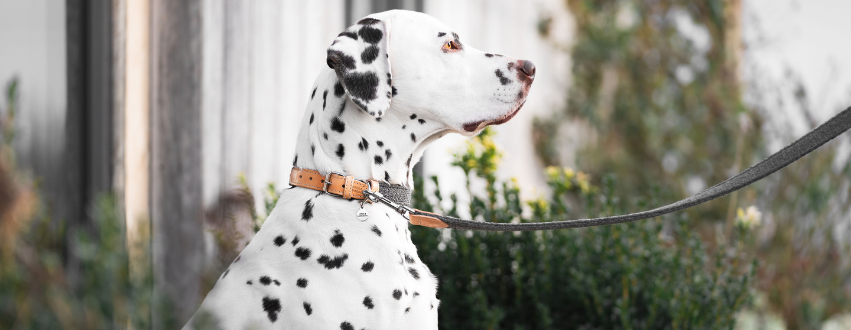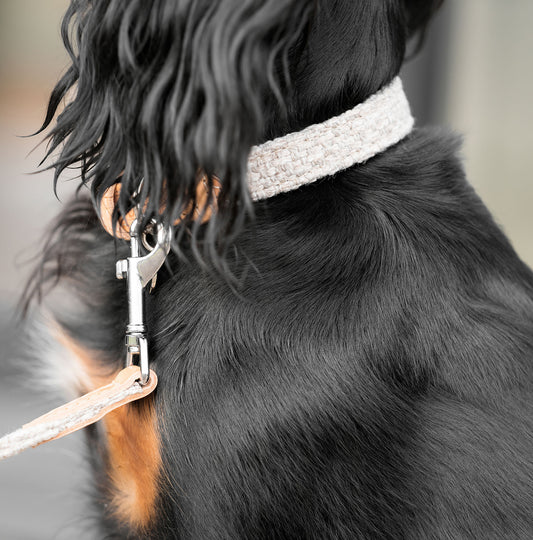It’s the duty of every dog owner to maintain the health and development of their furry friend. Part of this is feeding them quality food, making sure they eat enough each day and carrying out training to benefit their long-term and establish what is and isn’t acceptable. Another crucial element of dog ownership is ensuring that they’re getting enough exercise by taking them for daily dog walks.
In this guide, we explain how you can train your dog to behave on walks and answer a range of important questions around dog walking to improve you and your pooch’s experience.
How To Train A Dog To Walk

As a starting position, you should hold the dog lead in your left hand and treats in your right hand. Your dog can then cross diagonally from your left hand with the treats above their head as an incentive to walk. You can reverse hands if you’d prefer, as long as the lead is crossing your body and the treats remain above their head.
When you start to walk, raise your hand to the height of your shoulder and give a clear, consistent instruction such as ‘with me’ to indicate that you want them to move forward. Once they’ve moved forward as you instructed, give them a treat to reward them for following your instructions.
During your walk, if your dog starts to stray from you, hold your position and stand still until they’re beside you and back in the starting position. Continue to repeat these steps for walking your dog, rewarding them when they stick to your instructions, and they should eventually learn the dos and don’ts.
Additional steps for getting your dog to walk include:
- Reward them after a successful walk
- Use a short lead to communicate better with your dog
- Walk in front of your dog to establish your dominance
- Keep the lead on your dog after the walk to continue training at home.
How Often Should You Walk Your Dog
The recommended frequency of dog walks is entirely dependent on the breed of your dog. Generally speaking though, most dogs require at least one walk per day, as even smaller dogs need exercise and stimulation. As for larger or more energetic dogs, two or even three walks a day may be necessary to sufficiently exercise them and tire them out.
How To Stop My Dog Barking While Out Walking

An obstacle that may arise during dog walks is outside influences that cause your dog to bark. Whether it’s people, vehicles, the weather, other dogs or even just the excitement of the walk itself, many things can cause your dog to bark. This can ruin the experience for you and it can be unsettling for other people in the area if your dog is constantly barking.
Although your dog’s knee-jerk reaction of spontaneously barking while on walks may seem hard to prevent, you may in fact be able to find a relatively simple solution. The three primary options are:
- Distraction - As soon as your dog barks, get their attention and give them a treat as soon as they look at you. Continue to do this, including a consistent word to indicate what you’re doing, such as ‘look’. You can also decrease the chance of coming into contact with things that may cause your dog to bark by avoiding busy areas and immediately walking away from anything that causes them to bark. As an additional measure, you could bring their favourite squeaky toy as an effective distraction.
- Control - Ensure that your dog’s harness is tight enough to hold them if they’re prone to lunging when they bark. When they start barking, command them to heel, holding them firmly by the lead but not so tight that it hurts them, and reward them when they do as you say. By controlling their movement, you’ll also be discouraging them from barking or becoming flustered or overly excitable by minor influences.
- Desensitise - When you’ve got a grasp of exactly what is causing your dog to bark, identify it on your next walk and stand as a barrier between your dog and the trigger. As soon as your dog stops barking, reward them with a treat, and continue to do this, moving further out of the way until your dog is side by side with the thing that sets them off.
How To Stop A Dog Sniffing While Walking
Along with barking, sniffing is another behaviour that can delay and disrupt your dog walk. Unfortunately, with some dogs, sniffing can be something they do relentlessly as they excitedly explore the area they’re in. Within your home, there are several methods of preventing your dog from sniffing around people, other animals and anything else they come into contact with. However, there’s a general approach for preventing unwanted sniffing during walks:
To train your dog to stop sniffing, start by teaching them ‘sit’ and ‘leave it’ commands. Then, when you take them on their next walk, let them sniff what you’re happy with, but if they start sniffing something you’re not happy with, use a ‘sit’ or ‘leave it’ command to get them to stop. When they’ve resisted the urge to sniff following your command, reward them with a treat.
Why Can’t My Dog Walk Straight

If your dog isn’t walking in a straight line, you may be concerned that there’s something seriously wrong with them, but it’s actually a relatively common problem. Walking in a peculiar fashion or moving in a sideways motion is prevalent among specific breeds such as German shepherds, border collies, pointers, spaniels and vizslas. These quirks in their movement are primarily caused by their body shape and genetics
If your dog is a different breed, this issue could be caused by a distraction that’s leading them to edge away from your path. If this is the case, the distraction techniques used to stop them barking or sniffing may be a suitable solution. Alternatively, it could be the case that they have a problem with their joints. If training doesn’t fix their walking pattern, you should consider taking your dog to a vet.
How To Protect Your Dog From Other Dogs While Walking
Your pet is likely to see other dogs during walks, and when they do, they may become very anxious or aggressive. This is because they might perceive another dog as a threat or simply become too excited and not know how to deal with it.
Standing between your dog and other dogs will help to prevent them from seeing each other and reduce the risk of the situation escalating. You can also use distractions - whether it’s through treats, squeaky toys or commands - to deter your dog from reacting in a bad way. If you’re unable to prevent a confrontation between dogs that are off their leads, the best thing you can do is attempt to get their attention at a distance. You may be tempted to split them up yourself, but this is only likely to get them more excitable and may even lead to you or the dogs being injured.
































































































